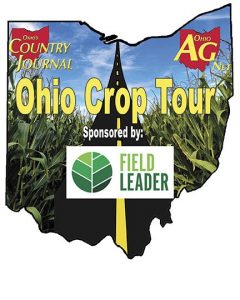2021 Ohio Crop Tour Results
By Matt Reese and Dusty Sonnenberg
According to the U.S. Department of Agriculture National Agricultural Statistics Service, Ohio’s 2021 average corn yield was 193 bushels per acre, up 22 bushels from 2020. Ohio’s average soybean yield for 2021 was 56.5 bushels per acre, up 1.5 bushels from 2020. Growers harvested 4.88 million acres, down 1% from 2020. Production, at 276 million bushels, was up 2% from 2020.
Our corn yield estimates made back in August, by in large, were on the low side of yields when compared to the actual yields harvested from the fields. On the in-person leg of the 2021 Ohio Crop Tour we had one group collect samples in 12 counties in northern Ohio and another group collect samples in southern Ohio. In addition, we had nearly 60 entries from around the state in our Virtual Crop Tour for corn and soybeans. Many of these samples were provided with cooperation from Ohio State University Extension educators.
During the week of Aug. 9, the tour totals for corn (multiplied by an agronomic fudge factor of .9 for corn yield estimates) generated a final yield of 181.83 bushels per acre for a statewide average yield, obviously on the low side when compared to the final USDA numbers. Our soybean estimate for the state came in right at 55 bushels, nearly spot-on with the final average state yield.
We followed up with some of the in-person stops to check the actual yield of the corn fields sampled. Here’s what we found.
Crawford Co.: 190 (estimate) 269 (actual)
Defiance Co.: 198 (estimate) 215 (actual)
Delaware Co.: 229 (estimate) 208 (actual)
Fairfield Co.: 191 (estimate) 227.5 (actual)
Greene Co.: 270 (estimate) 292 (actual)
Hancock Co.: 186 (estimate) 233 (actual)
Hardin Co: 175 (estimate) 165 (actual)
Henry Co.: 181 (estimate) 207.6 (actual)
Madison Co.: 198 (estimate) 216 (actual)
Paulding Co.: 197 (Estimate) 215 (actual)
Pickaway Co.: 185 (estimate) 198 (actual)
Putnam Co.: 178 (estimate) 187 (actual)
Wyandot Co.: 219 (estimate) 221 (actual)
The tour certainly found some big yields, particularly in the northern part of the state, but also revealed some surprisingly dry and challenging growing conditions in other places. We thought the lack of water going into the tour for many parts of the state would likely knock the top end off of some of those bigger yields for corn and soybean yields.
Strong crop prices in 2021 had the fungicide applicators busy, which significantly slowed (or stopped) disease issues in many areas, but we certainly saw the potential for disease problems to develop in 2021 in untreated fields. Insect feeding issues seemed to be generally low statewide though a handful of soybean aphids were starting to show up, along with the other usual suspects.
It was also apparent that there was too much moisture early in some fields that led to stand issues and replant situations in some areas. At Crop Tour time, many of those same areas were facing some of the state’s dry conditions in an unfortunate double-whammy.
Despite the challenges, though, there were many fields of extremely good crops out there in every part of the state due to incredible genetics, generally cooperative weather conditions and top-notch management from planting through harvest by Ohio’s corn and soybean farmers. And, based on our low estimates, those good crops we found out there were even better than we thought.